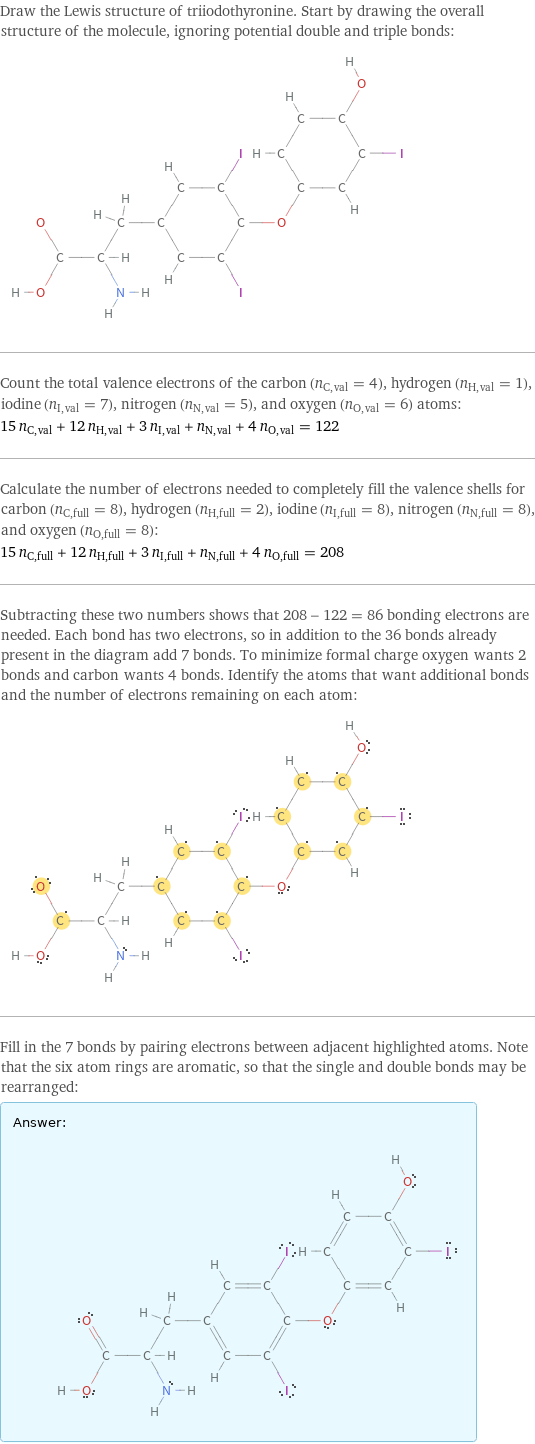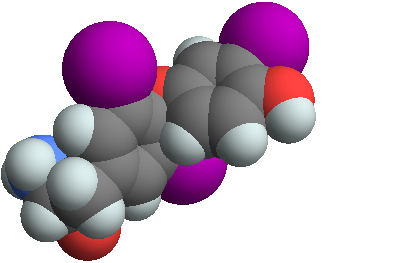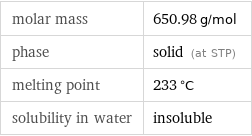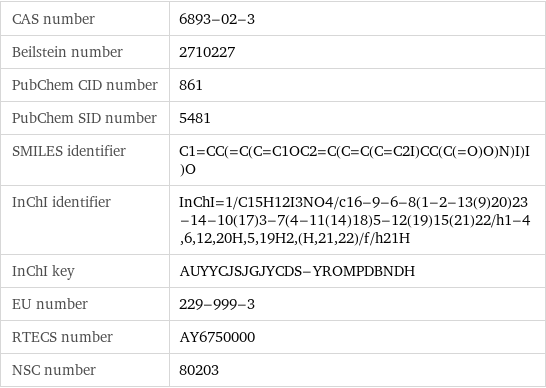Input interpretation

triiodothyronine
Chemical names and formulas
![formula | C_15H_12I_3NO_4 name | triiodothyronine IUPAC name | 2-amino-3-[4-(4-hydroxy-3-iodo-phenoxy)-3, 5-diiodo-phenyl]propanoic acid alternate names | L-3, 3', 5-triiodothyronine mass fractions | C (carbon) 27.7% | H (hydrogen) 1.86% | I (iodine) 58.5% | N (nitrogen) 2.15% | O (oxygen) 9.83%](../image_source/29428e5c8066700c88b4cdb0b959d70a.png)
formula | C_15H_12I_3NO_4 name | triiodothyronine IUPAC name | 2-amino-3-[4-(4-hydroxy-3-iodo-phenoxy)-3, 5-diiodo-phenyl]propanoic acid alternate names | L-3, 3', 5-triiodothyronine mass fractions | C (carbon) 27.7% | H (hydrogen) 1.86% | I (iodine) 58.5% | N (nitrogen) 2.15% | O (oxygen) 9.83%
Lewis structure

Draw the Lewis structure of triiodothyronine. Start by drawing the overall structure of the molecule, ignoring potential double and triple bonds: Count the total valence electrons of the carbon (n_C, val = 4), hydrogen (n_H, val = 1), iodine (n_I, val = 7), nitrogen (n_N, val = 5), and oxygen (n_O, val = 6) atoms: 15 n_C, val + 12 n_H, val + 3 n_I, val + n_N, val + 4 n_O, val = 122 Calculate the number of electrons needed to completely fill the valence shells for carbon (n_C, full = 8), hydrogen (n_H, full = 2), iodine (n_I, full = 8), nitrogen (n_N, full = 8), and oxygen (n_O, full = 8): 15 n_C, full + 12 n_H, full + 3 n_I, full + n_N, full + 4 n_O, full = 208 Subtracting these two numbers shows that 208 - 122 = 86 bonding electrons are needed. Each bond has two electrons, so in addition to the 36 bonds already present in the diagram add 7 bonds. To minimize formal charge oxygen wants 2 bonds and carbon wants 4 bonds. Identify the atoms that want additional bonds and the number of electrons remaining on each atom: Fill in the 7 bonds by pairing electrons between adjacent highlighted atoms. Note that the six atom rings are aromatic, so that the single and double bonds may be rearranged: Answer: | |
3D structure

3D structure
Basic properties

molar mass | 650.98 g/mol phase | solid (at STP) melting point | 233 °C solubility in water | insoluble
Units

Hydrophobicity and permeability properties

experimental LogP hydrophobicity | 2.9 predicted LogP hydrophobicity | 0.82 experimental LogS | -5.22 predicted LogS | -4.52
Basic drug properties

approval status | approved | small molecule drug categories | hormone replacement agent dosage forms | oral: tablet

brand names | cytomel | tertroxin | tresitope | triostat
Chemical identifiers

CAS number | 6893-02-3 Beilstein number | 2710227 PubChem CID number | 861 PubChem SID number | 5481 SMILES identifier | C1=CC(=C(C=C1OC2=C(C=C(C=C2I)CC(C(=O)O)N)I)I)O InChI identifier | InChI=1/C15H12I3NO4/c16-9-6-8(1-2-13(9)20)23-14-10(17)3-7(4-11(14)18)5-12(19)15(21)22/h1-4, 6, 12, 20H, 5, 19H2, (H, 21, 22)/f/h21H InChI key | AUYYCJSJGJYCDS-YROMPDBNDH EU number | 229-999-3 RTECS number | AY6750000 NSC number | 80203
Toxicity properties

RTECS classes | drug | reproductive effector